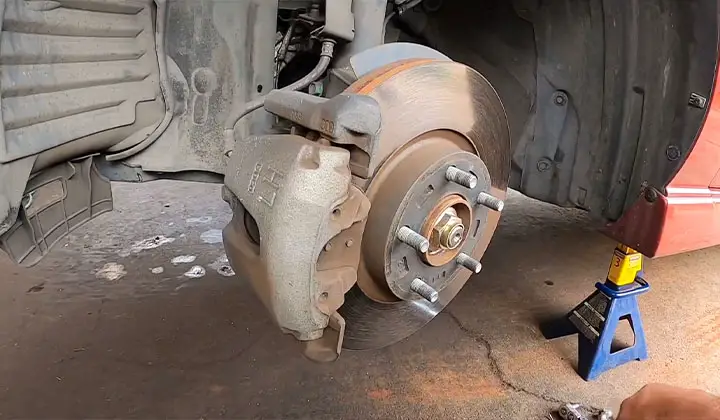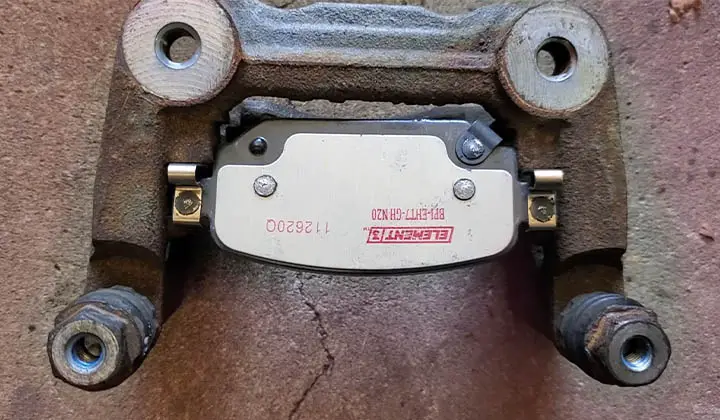On most cars, however, you can expect to change your brake pads between every 25 and 70 thousand miles of driving. But for Mazda, frequent braking, aggressive braking, and several more reasons to replace them before time.
Contents
How often should Mazda brake pads be replaced?
On most cars, you can expect your brake pads will last between 50 and 70 thousand miles of driving. Sure, this interval may seem large, but this can vary due to your personal driving habits, your driving conditions, and what you regularly encounter while on the road.
Driving through cities like Boise and Caldwell involves frequent braking, mountainous Idaho driving will cause additional wear and tear on your brake pads or if you are constantly stomping on the brakes, your brake pads may only last about 25,000 miles.

When the brakes should be inspected
The best time to inspect your brakes is whenever you have your Mazda’s oil changed and when the tires are rotated. Once in a while, you can do regular checkups on them. But you will soon find some signs of worn-out brakes.
The signs of worn-out brakes
All modern brake pads have a wear indicator that makes a squealing sound. This will hint you to replace the pads. You will hear it every time you stop.
The most common signs of worn-out brake pads are grinding, scraping, or squealing noises when applying the brakes. Vehicle vibrates when brakes are applied may be a sign of warped brake rotors too.
When to change the brake pads
Mazda performs extremely well in heavy traffic because of its high-quality brake pads. But after a while, those brake pads will wear down and you will need to change them to continue enjoying the top-notch performance.
On average, most brake pads will last about 50 thousand miles. But if your daily commute involves a lot of traffic lights, or if you are constantly stomping on the brakes, then your brake pads may only last about 25 thousand miles or so.
Mazda Brake pads replacement cost
The cost of replacing brake pads on a Mazda vehicle can range from $150 to $200, depending on the type of brake pads and the labor charges of the shop you choose.
It is important to choose a shop whose technicians are specifically trained in Mazda vehicles, as they will use genuine Mazda parts for your brake pad replacement.
The lasting time of Mazda brake pads depends on several factors, including the driving style and the routine car maintenance performed.
Aggressive driving, riding the brakes, and frequent city driving can cause the brake pads to wear down more quickly, while slow and steady driving and highway driving can result in less brake wear.
It is important to have your brakes checked regularly and replace the brake pads as needed to ensure the safety and performance of your vehicle.
The brake pads are a crucial part of the braking system and it is essential to have them replaced by trained technicians with genuine Mazda parts.
Brake pad lasting time
The lasting time of Mazda brake pads can vary depending on several factors, including the driving style and the environment in which you drive.
Generally, brake pads can last anywhere from 25,000 to 70,000 miles, although this can vary greatly depending on the specific make and model of the vehicle, as well as the driving habits and conditions.
The way you drive
The way you drive can have a significant impact on the lifespan of your brake pads. If you have a tendency to drive aggressively and make sudden stops, your brake pads will wear down faster than if you are a more cautious driver.
This is because every time you press the brake pedal, the brake pads are compressed against the brake rotors, generating heat and wearing down the friction material on the brake pads.
On the other hand, if you are a slow and steady driver, your brake pads will likely last longer. Gentle brake application puts less stress on the brake pads, reducing the amount of wear and tear.
However, even if you are a slow driver, if you have a tendency to “ride the brakes” by keeping your foot on the pedal, your brake pads will still wear down more quickly.
It is important to be aware of your driving habits and make adjustments to extend the life of your brake pads and ensure the safety of your vehicle.
Slow driver
If you are a slow driver, it can be beneficial for the lifespan of your brake pads. Slow and steady driving puts less stress on the brake system, reducing the wear and tear on the brake pads. This can result in longer-lasting brake pads and fewer brake problems.
However, even if you are a slow driver, it is still possible to wear down your brake pads quickly if you tend to “ride the brakes.”
This means that you keep your foot on the brake pedal even when you are not slowing down or stopping, causing the brake pads to be compressed against the brake rotors and generating heat. This can result in faster wear of the brake pads.
It is important to drive in a safe way and considerate of your brake system. Gentle braking, avoiding sudden stops, and reducing the amount of time you keep your foot on the brake pedal can all help extend the life of your brake pads.
Where you drive
The environment where you drive can also have an impact on the lifespan of your brake pads. If you frequently drive in the city, where there are many stop lights and a lot of traffic, you will likely use your brakes more frequently than if you mostly drive on the highway. This increased use of the brakes can result in faster wear of the brake pads.
Driving in hilly areas can also put additional stress on your brake system, as you will need to use your brakes more often to slow down or stop on inclines. This can result in faster wear of the brake pads.
On the other hand, if you mostly drive on the highway, where there is less traffic and fewer stops, you will likely use your brakes less often, resulting in less wear on the brake pads.
It is important to be aware of the environment where you drive and make adjustments as necessary to extend the life of your brake pads and ensure the safety of your vehicle. Regular maintenance and inspections of your brake system can also help identify any potential problems and prevent excessive wear of your brake pads.
Driving affects the brake pads
Driving style and environment can greatly affect the lifespan of brake pads. Aggressive driving, frequent stops, and riding the brakes can cause faster wear, while slow and steady driving can extend their life.
Driving in a city with traffic can also result in faster wear, while highway driving and less traffic can result in less wear. Regular maintenance and inspections can prevent excessive wear and ensure the safety of your vehicle.
Mazda brake pads
Mazda brake pads are a crucial component of the braking system, but eventually, they will wear down and need to be replaced.
This is a normal part of routine car maintenance and the lifespan of the brake pads can be affected by factors such as driving style and environment. Regular inspections and maintenance can help ensure the safety and performance of your Mazda vehicle.
City drivers
That’s correct, city driving can cause more wear on the brake pads compared to highway driving. The frequent braking and stopping in stop-and-go traffic can result in faster wear of the friction material on the brake pads, causing the need for a replacement sooner.
On average, city drivers can expect to need new brake pads between 30,000 and 60,000 kilometers, but this can vary depending on driving habits and other factors.
It’s important for city drivers to have their brakes inspected regularly and to replace the brake pads as needed to ensure the safety and performance of their vehicles.
Regular maintenance and inspections can also help prevent excessive wear and identify any potential problems before they become more serious.
Countryside drivers
Highway driving typically involves fewer braking actions compared to city driving, which can result in less wear on the brake pads. Additionally, highway driving often involves higher speeds, but the decreased frequency of braking can still result in longer-lasting brake pads.
It is not uncommon for drivers who primarily drive on the highway to get up to 100,000 kilometers or more before needing to replace their brake pads. However, this can still vary depending on driving habits and other factors.
It’s important for all drivers to have their brakes inspected regularly and to replace the brake pads as needed, regardless of the type of driving they do. Regular maintenance and inspections can help ensure the safety and performance of the vehicle and prevent excessive wear of the brake pads.
Help your brake system
Regular brake maintenance, as recommended by Mazda, is essential to extend the life of your vehicle’s braking system. Schedule brake pad and disc service every 12 months or 24,000km to remove contaminants and keep the brakes working at their best. This simple step helps ensure the safety and performance of your vehicle.
Important factors for Mazda brake pad life
Certain driving habits and conditions put more stress on the brakes — not to mention the transmission system and engine.
Driving habits
If you tend towards aggressive driving habits like riding and slamming the brakes, then your brake pads will wear out faster. Try to stop with gentle pressure on the brake pedal, because this can help preserve them.
Driving Environment
If most of your driving takes place on the highway, you can probably expect your brake pads to last a little longer than normal.
Meanwhile, stop-and-go city driving requires more braking and wears the brake pads out faster.
Brake Material
Many high-end vehicles are available with carbon-ceramic brakes. While carbon fiber can be a costly upgrade, they last longer than metal brakes and will require less frequent brake pad changes.

FAQ
1. How much does a full brake job cost?
Answer: A complete brake repair like pads, rotors, and calipers replacement can cost between $300 and $800. However, depending on the make and model of your vehicle, you can easily spend more than $1,000 on a complete brake job.
2. When should I change my brake pads Mazda 3?
Answer: There are several indications like high pitched squeal when braking, high mileage on existing pads, brake system warning lights or maintenance reminder messages, etc.
3. What brand of brake pads does Mazda use?
Answer: Mazda uses Akebono Brake Products. They are trusted by Original Equipment Manufacturers Worldwide.
Conclusion
Try to take your Mazda car to a technician about maintenance checks. From tire treads to engine oil, the technician will cover it. When the times come, you have to change your Mazda brake pads to get a smooth ride.
